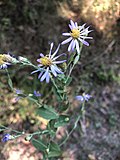| Symphyotrichum patens | |
|---|---|

| |
| In Polkton, North Carolina | |
| Conservation status | |
 Secure (NatureServe) | |
| Scientific classification | |
| Kingdom: | Plantae |
| Clade: | Tracheophytes |
| Clade: | Angiosperms |
| Clade: | Eudicots |
| Clade: | Asterids |
| Order: | Asterales |
| Family: | Asteraceae |
| Tribe: | Astereae |
| Subtribe: | Symphyotrichinae |
| Genus: | Symphyotrichum |
| Subgenus: | Symphyotrichum subg. Virgulus |
| Section: | Symphyotrichum sect. Patentes |
| Species: | S. patens |
| Binomial name | |
| Symphyotrichum patens (Aiton) G.L.Nesom | |
| Varieties | |
List
| |

| |
| County-level distribution map of Symphyotrichum patens | |
| Synonyms | |
|
Basionym
| |
Symphyotrichum patens, commonly known as late purple aster or spreading aster, is a perennial, herbaceous plant found in the eastern United States.
Description
Sympyotrichum patens is a perennial and herbaceous flowering plant usually between 10 and 100 centimeters (1⁄4 and 3+1⁄4 feet) tall. It has a spreading growth form, and the leaves are ovate to oblong and clasp the pubescent stem. The flowers are relatively small, less than 3 centimeters (1+1⁄4 inches) in diameter, with light blue to violet ray florets and yellow disk florets. It flowers between August and October.
Taxonomy
The title of a review of the Symphyotrichum patens complex begins with "Another review..." as a nod to the complexity of the topic. The species was first formally described and named Aster patens by Swedish botanist Jonas Carlsson Dryander and published by Scottish botanist William Aiton in 1789. It was transferred to the genus Symphyotrichum in 1995 by American botanist Guy L. Nesom. It is closely related to Symphyotrichum georgianum and Symphyotrichum phlogifolium.
Several varieties have been named, with the basionym as Symphyotrichum patens var. patens:
- Symphyotrichum patens var. gracile (Hook.) G.L.Nesom
- Symphyotrichum patens var. patentissimum (Lindl.) G.L.Nesom
- Symphyotrichum patens var. terranigrum J.J.N.Campb. & W.R.Seymour
Distribution and habitat
A widely distributed species, S. patens ranges from southern Maine, south and west to eastern Texas. Plants are typically found in sunny to mostly sunny sites, including open woodlands.
Conservation
As of July 2021, NatureServe listed Symphyotrichum patens as Secure (G5) worldwide and Possibly Extirpated (SX) in Maine.
Citations
- ^ NatureServe 2021.
- ^ POWO 2019.
- ^ Campbell & Seymour 2014.
- ^ USDA 2014.
- ^ Brouillet et al. 2006.
- ^ Missouri Botanical Garden n.d.
- IPNI 2020a.
- IPNI 2020b.
- NC State Extension n.d.
References
- Brouillet, L.; Semple, J.C.; Allen, G.A.; Chambers, K.L.; Sundberg, S.D. (2006). "Symphyotrichum patens". In Flora of North America Editorial Committee (ed.). Flora of North America North of Mexico (FNA). Vol. 20. New York and Oxford: Oxford University Press. Retrieved 23 December 2019 – via eFloras.org, Missouri Botanical Garden, St. Louis, MO & Harvard University Herbaria, Cambridge, MA.
- Campbell, J.J.N.; Seymour, W.R. (Jr.) (1 December 2014). "Another review of the Symphyotrichum patens complex (Asteraceae), including a new variety of S. patens from the southern Blacklands, new records of S. georgianum, and notes on georgianum-like plants outside its known range" (PDF). Phytoneuron. 2014 (107). Fort Worth, Texas: Guy L. Nesom: 1–33. ISSN 2153-733X. Retrieved 6 July 2021.
- IPNI (2020a). "Aster patens [Dryand.]". International Plant Names Index (IPNI). Royal Botanic Gardens, Kew; Harvard University Herbaria & Libraries; Australian National Botanic Gardens. Retrieved 6 January 2020.
- IPNI (2020b). "Symphyotrichum patens (Aiton) G.L.Nesom". International Plant Names Index (IPNI). Royal Botanic Gardens, Kew; Harvard University Herbaria & Libraries; Australian National Botanic Gardens. Retrieved 6 January 2020.
- Missouri Botanical Garden (n.d.). "Symphyotrichum patens - Missouri Botanical Garden Plant Finder". www.missouribotanicalgarden.org. St. Louis. Retrieved 6 July 2021.
- NatureServe (2 July 2021). "Symphyotrichum patens Late Purple Aster". explorer.natureserve.org. Arlington, Virginia. Retrieved 6 July 2021.
- NC State Extension (n.d.). "Symphyotrichum patens". North Carolina Extension Gardener Plant Toolbox (plants.ces.ncsu.edu). Raleigh: North Carolina Cooperative Extension Service. Retrieved 6 July 2021.
- POWO (2019). "Symphyotrichum patens (Aiton) G.L.Nesom". Plants of the World Online. Royal Botanic Gardens, Kew. Retrieved 21 June 2021.
- NRCS (2014). "Symphyotrichum patens". PLANTS Database. United States Department of Agriculture (USDA). Retrieved 23 December 2019.
| Taxon identifiers | |
|---|---|
| Symphyotrichum patens |
|
| Aster patens | |




